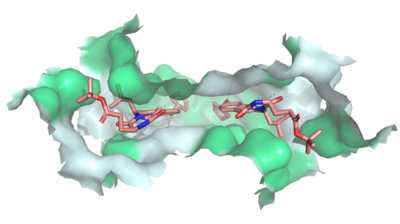Sandbox Reserved 1613
From Proteopedia
(Difference between revisions)
| Line 2: | Line 2: | ||
<StructureSection load='6ffc' size='350' frame='true' side='right' caption='Figure 1: ABCG2 6FFC' scene=’’> | <StructureSection load='6ffc' size='350' frame='true' side='right' caption='Figure 1: ABCG2 6FFC' scene=’’> | ||
==Introduction== | ==Introduction== | ||
| - | The ABCG2 transporter protein is a notable [https://en.wikipedia.org/wiki/Transmembrane_protein transmembrane protein]. It transports [https://en.wikipedia.org/wiki/Xenobiotic xenobiotic] material out of cells in many tissues. ABCG2 belongs to the family of 48 transporter proteins called ATP-binding cassette transporters (ABC transporters). The ABC transporters differ from each other by their size structure, and ordering of domains. Ample evidence has shown a link between [https://en.wikipedia.org/wiki/Multiple_drug_resistance multi-drug resistance] and the presence of ABC transporters in the plasma membrane of cells. This is important as multi-drug resistance is one of the major indicators of bad prognoses in cancer treatment. In fact, 19 of the 48 transporters of the ABC family have been shown to transport [https://en.wikipedia.org/wiki/List_of_chemotherapeutic_agents chemotherapeutic agents] out of cells<ref name="Robey">PMID:29643473</ref> In recent studies, with [https://en.wikipedia.org/wiki/Cryogenic_electron_microscopy cryogenic electronic microscopy] (Cryo EM), the unique <scene name='83/832939/2_cavities/1'>two cavity substrate transport structure</scene>, inward facing nucleotide binding domain and <scene name='83/832939/El-3/3'>condensed EL-3 structure</scene> of ABCG2 have been elucidated, among other features. These new discoveries have allowed for progress towards discovering the exact link between cancer and the ABC transporter family and have allowed for more effective drug treatment of cancer. This page will focus on the family of ABC transporters before delving into unique structural features of ABCG2 and finally describing the effects of this transporter on anti-cancer treatment. | + | The ABCG2 transporter protein is a notable [https://en.wikipedia.org/wiki/Transmembrane_protein transmembrane protein]. It transports [https://en.wikipedia.org/wiki/Xenobiotic xenobiotic] material out of cells in many tissues. ABCG2 belongs to the family of 48 transporter proteins called ATP-binding cassette transporters (ABC transporters). The ABC transporters differ from each other by their size structure, and ordering of domains. Ample evidence has shown a link between [https://en.wikipedia.org/wiki/Multiple_drug_resistance multi-drug resistance] and the presence of ABC transporters in the plasma membrane of cells. This is important as multi-drug resistance is one of the major indicators of bad prognoses in cancer treatment. In fact, 19 of the 48 transporters of the ABC family have been shown to transport [https://en.wikipedia.org/wiki/List_of_chemotherapeutic_agents chemotherapeutic agents] out of cells.<ref name="Robey">PMID:29643473</ref> In recent studies, with [https://en.wikipedia.org/wiki/Cryogenic_electron_microscopy cryogenic electronic microscopy] (Cryo EM), the unique <scene name='83/832939/2_cavities/1'>two cavity substrate transport structure</scene>, inward facing nucleotide binding domain and <scene name='83/832939/El-3/3'>condensed EL-3 structure</scene> of ABCG2 have been elucidated, among other features. These new discoveries have allowed for progress towards discovering the exact link between cancer and the ABC transporter family and have allowed for more effective drug treatment of cancer. This page will focus on the family of ABC transporters before delving into unique structural features of ABCG2 and finally describing the effects of this transporter on anti-cancer treatment. |
==ABC Transporter Family== | ==ABC Transporter Family== | ||
Revision as of 11:11, 21 April 2020
ABCG2 Transporter Protein
| |||||||||||
References
- ↑ 1.0 1.1 1.2 Robey RW, Pluchino KM, Hall MD, Fojo AT, Bates SE, Gottesman MM. Revisiting the role of ABC transporters in multidrug-resistant cancer. Nat Rev Cancer. 2018 Jul;18(7):452-464. doi: 10.1038/s41568-018-0005-8. PMID:29643473 doi:http://dx.doi.org/10.1038/s41568-018-0005-8
- ↑ 2.0 2.1 Manolaridis I, Jackson SM, Taylor NMI, Kowal J, Stahlberg H, Locher KP. Cryo-EM structures of a human ABCG2 mutant trapped in ATP-bound and substrate-bound states. Nature. 2018 Nov;563(7731):426-430. doi: 10.1038/s41586-018-0680-3. Epub 2018 Nov, 7. PMID:30405239 doi:http://dx.doi.org/10.1038/s41586-018-0680-3
- ↑ 3.0 3.1 Jackson SM, Manolaridis I, Kowal J, Zechner M, Taylor NMI, Bause M, Bauer S, Bartholomaeus R, Bernhardt G, Koenig B, Buschauer A, Stahlberg H, Altmann KH, Locher KP. Structural basis of small-molecule inhibition of human multidrug transporter ABCG2. Nat Struct Mol Biol. 2018 Apr;25(4):333-340. doi: 10.1038/s41594-018-0049-1. Epub, 2018 Apr 2. PMID:29610494 doi:http://dx.doi.org/10.1038/s41594-018-0049-1
- ↑ Fetsch PA, Abati A, Litman T, Morisaki K, Honjo Y, Mittal K, Bates SE. Localization of the ABCG2 mitoxantrone resistance-associated protein in normal tissues. Cancer Lett. 2006 Apr 8;235(1):84-92. doi: 10.1016/j.canlet.2005.04.024. Epub, 2005 Jun 28. PMID:15990223 doi:http://dx.doi.org/10.1016/j.canlet.2005.04.024
- ↑ [ https://en.wikipedia.org/wiki/ABCG2 "ABCG2 -." Wikipedia, the Free Encyclopedia. Web. 20 Apr. 2020].
- ↑ Taylor NMI, Manolaridis I, Jackson SM, Kowal J, Stahlberg H, Locher KP. Structure of the human multidrug transporter ABCG2. Nature. 2017 Jun 22;546(7659):504-509. doi: 10.1038/nature22345. Epub 2017 May, 29. PMID:28554189 doi:http://dx.doi.org/10.1038/nature22345
- ↑ Cleophas MC, Joosten LA, Stamp LK, Dalbeth N, Woodward OM, Merriman TR. ABCG2 polymorphisms in gout: insights into disease susceptibility and treatment approaches. Pharmgenomics Pers Med. 2017 Apr 20;10:129-142. doi: 10.2147/PGPM.S105854., eCollection 2017. PMID:28461764 doi:http://dx.doi.org/10.2147/PGPM.S105854
Student Contributors
Shelby Skaggs, Samuel Sullivan, Jaelyn Voyles

